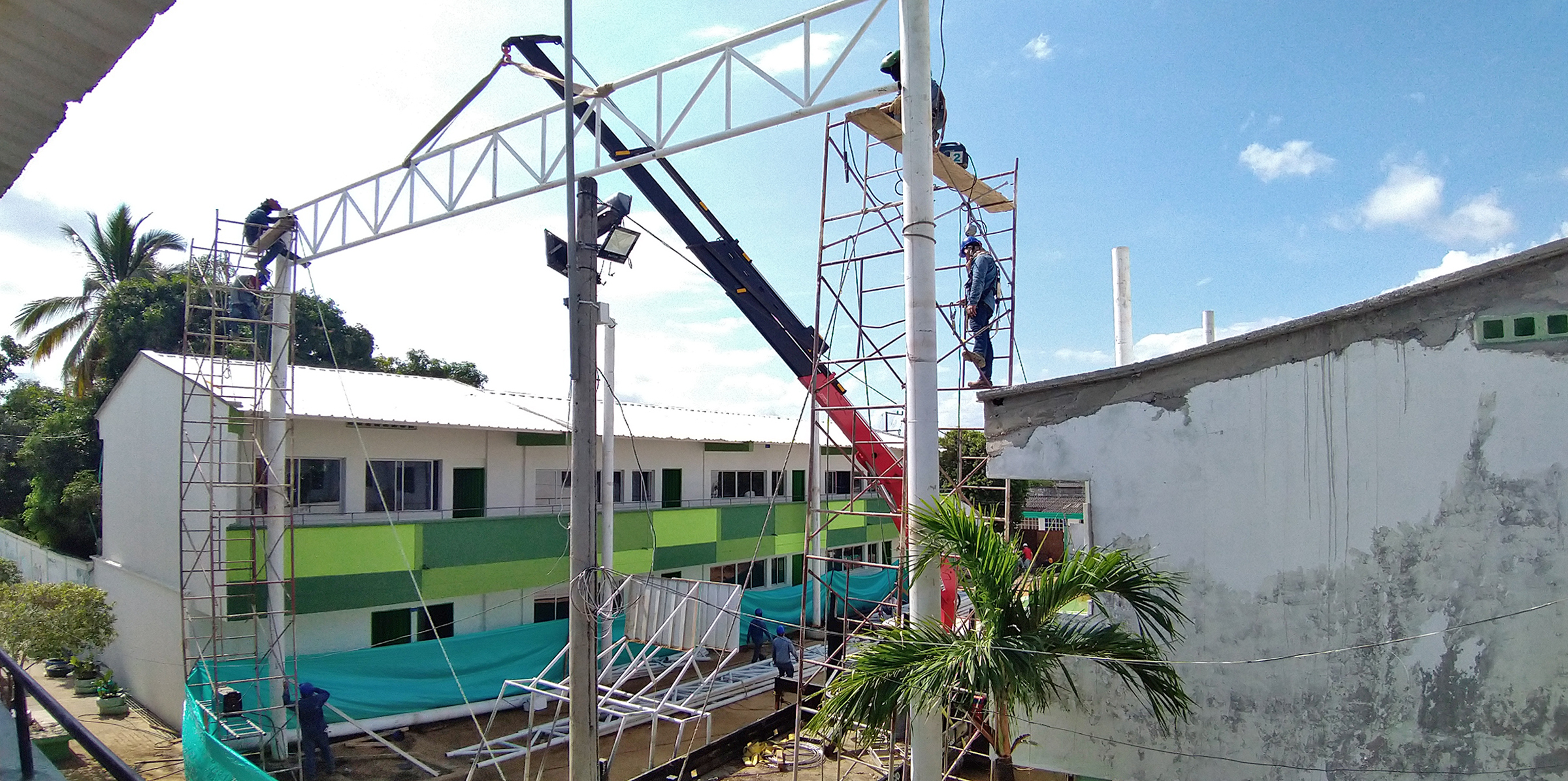Our projects help to reduce carbon emissions
EBP is committed to reducing its own carbon footprint. Some of the company’s measures include offering reimbursements to encourage employees to choose public transportation, outfitting company buildings with energy-efficient HVAC systems, and encouraging employees to be mindful of the little things, like remembering to turn off lights. According to its mission, however, our EBP experts also help our clients to realize impressive emissions reductions in the context of planning for and executing their projects.
“We have the privilege of helping our clients to complete their new-construction and renovation projects in a manner that secures greater energy efficiency.”
“By striving to reduce our own carbon footprint with well-targeted quality-management initiatives and by emphasizing energy efficiency in our project work, we are proud to be making an important contribution to a more sustainable economy,” says Carolyn Bodmer, head of quality and environmental management at EBP. Many client projects in the transportation, energy, technology and construction sectors present opportunities to reduce especially large amounts of greenhouse gases. Given that buildings account for around one-third of all greenhouse gas emissions and 40 percent of overall energy consumption in Switzerland, the construction sector, in particular, offers the greatest potential. For instance, renovating buildings with an eye to greater sustainability can help us to lower carbon emissions by more than 50 percent.
Helping our clients around the world to lower their carbon emissions
“Both in Switzerland and abroad, we have the privilege of helping our clients to complete their new-construction and renovation projects in a manner that secures greater energy efficiency,” says Bodmer, summarizing the company’s global reach. EBP’s specialists provide advice and support to governments, international organizations and standards-setting enterprises like Minergie. They offer solutions for all phases of new-build and renovation projects, from ideation and strategic development to planning, realization and building operation.
Swiss buildings program: 13-million-ton reduction in CO2 emissions
In 2009, the Swiss parliament passed a measure to allocate a portion of federal revenue from the Swiss CO2 tax to promote efforts to reduce carbon emissions from buildings. Known as “The Buildings Program,” this initiative soon became one of Switzerland’s largest subsidy programs. The aim of the program is to encourage owners to renovate their buildings with an eye to energy efficiency and the use of renewable energies. Acting in the capacity of an official consultant for building envelopes from 2010 to 2016, EBP helped to secure the program’s smooth and professional operation.

“The Buildings Program led to the establishment of the triple-glazed window as a market standard.”
Up to CHF 300 million was allocated each year throughout the program’s seven-year implementation, enabling the renovation of around 90,000 buildings, including single-family homes, office buildings, and commercial buildings. “The program was so popular among building owners that we needed to make allocation adjustments after the first year so as not to drain available funding before the program’s expiration,” recalls Sabine Perch-Nielsen, an energy and climate expert, who was closely involved in the project’s administration. “We set new priorities to ensure both the equitable and effective distribution of funds and the greatest possible reduction in carbon emissions.”
To ensure a capacity to process the high number of applications, EBP’s IT department created a management-information system (MIS) to enable digital-application submissions, track the status of projects, and permit regional offices to conveniently access information on allocated and promised funding. Communications specialists at EBP also supported the entire process by arranging media conferences, drafting policy statements and providing online and offline services (exhibitions, newsletters, annual reports, etc.).
This enabled the Swiss Federal Office of Energy, the Federal Office for the Environment, and the Conference of Cantonal Energy Directors to more efficiently manage and implement funding measures and to ultimately achieve a reduction in total CO2 emissions of around 13 million tons over the course of the program, a volume of energy output that corresponds to 62 terawatt hours. New and more energy efficient standards were also introduced. “For instance, the Buildings Program led to the establishment of the triple-glazed window as a market standard,” says Perch-Nielsen.
Implementing regional energy initiatives in Germany
In passing its Federal Climate Change Act in 2019, the German parliament codified into law its intention to transform its energy-supply system for greater sustainability and become climate-neutral by 2050. This goal is significantly more ambitious than the country’s first climate initiatives spearheaded by a consortium of regional administrations in the federal state of Brandenburg in 2013. Given the new federal initiative, EBP has assembled an interdisciplinary team of German and Swiss experts to examine the implementation of the original four regional initiatives to ascertain current potential for greater energy efficiency and an increased use of renewable sources of energy. For instance, this potential may exist in the area of transportation where new hydrogen-fuel-cell and battery-electric powertrain concepts have emerged as viable alternatives.
Equipped with updated estimates of potential and newly adjusted scenarios, the EBP team is also drafting a climate-neutrality action plan to assist regions in their efforts to achieve climate neutrality by 2050. The plan is to reflect the changed legal framework, new technologies, and current socioeconomic conditions. A new tracking mechanism is also to be introduced to track general progress and the effectiveness of each measure. One particular challenge in this connection will be to develop a common set of guidelines despite the different starting points of the various regions. “In approaching this task, we need to place a premium on sensitivity and close consultation with our clients,” says Corinna Berger, a member of the EBP project team. “In bilateral consultations and joint conferences with all four clients, our aim is to establish a common denominator and to implement this common denominator so as to deliver the greatest added value measured against the energy targets, and to exploit synergies, for instance, through shared public-relations strategies. It certainly helps in this regard that we have a motivated team of German and Swiss colleagues.”
Aiming for energy efficiency in the Caribbean
In addition to its activities in Europe, EBP also helps clients on other continents to reduce their carbon footprints. In Colombia, for instance, EBP is overseeing efforts to establish the Swiss energy-efficiency standard known as EnergyCity. The Colombian government would like to implement the standard as a means of promoting energy efficiency, sustainable forms of transportation, and the greater use of renewable energies.

“The measures enabled us to lower energy costs and reduce carbon emissions by 60 tons.”
One specific project initiated in the framework of these efforts was the renovation of the Juan XXIII public school in the city of Monteria. EBP oversaw the project from its conception to its implementation. “We developed the energy concept, drafted the calls to tender, selected local contractors and managed the project’s on-site realization,” says EBP’s Roger Walther, who headed up the project. Special challenges included ensuring adherence to the specified technical quality during the project’s execution, completing the renovation without interrupting school operation, and ensuring the applicability of the experience gained to subsequent projects. “To meet these challenges and to account for the various interests involved, we included all of the project’s stakeholders in the planning process at an early stage,” recalls Walter. “Beyond that, we made sure to include a high level of local input throughout the process, for instance, by engaging local engineers and contractors.”
In order to preserve the most important findings for future use, a dedicated manual was created to compile the experiences of the main stakeholders (e.g. engineers, planners, municipalities, and even school children). The planning team also installed a monitoring system to continuously evaluate adherence to the project’s main specifications, as relating, for instance, to carbon emissions, the cost of energy, and classroom temperature and humidity. “The measures enabled us to lower the average classroom temperature from 95 to 81°F, convert the school’s electrical system to a solar system, lower energy costs and reduce carbon emissions by 60 tons.”